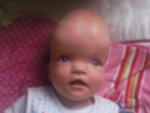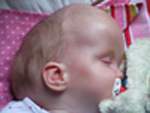Macrocephaly
Description
Macrocephaly is a condition in which the head is larger than normal.
Also called macrocephalia and megalocephaly, macrocephaly is diagnosed when the circumference of the head is more than two standard deviations above average for the child's age, sex, race, and period of gestation.

The fontanelle (soft spot) of the newborn is wide, but facial features are usually normal. Macrocephaly is distinguished from hydrocephalus in that there is no increase in pressure within the head; however, hydrocephalus can result in macrocephaly in some children. The disorder can result from a defect in formation during the embryonic stage, as a result of certain degenerative diseases, as a part of various genetic syndromes, or as an inherited family trait. Mental deficiency, seizures, and movement disorders are common in macrocephalic children.
Demographics
Because of the many conditions that cause macrocephaly, a true assessment of its incidence is difficult. It is a relatively rare condition that does not appear to affect children of any particular race, gender, or nationality with more frequency.
Causes and symptoms
Macrocephaly may be caused by many conditions. The most common causes for an enlarged head are megalencephaly, or an enlarged brain, and hydrocephalus, or excessive cerebrospinal fluid (CSF) in the brain.
When macrocephaly is a result of megalencephaly, it is often impossible to determine the cause. However, megalencephaly is often associated with metabolic diseases such as Canavan's disease or Alexander's disease or with syndromes such as gigantism, achondroplasia (dwarfism or small stature), osteogenesis imperfecta, neurofibromatosis, and some chromosomal anomalies. In each of these disorders, there is an enlargement of brain tissues.
In hydrocephalus, excess CSF collects in the large sections of the brain called the ventricles. This may occur for many reasons, including Chiari malformation, abnormal cysts within the brain, and infections such as meningitis.

In some cases, a child may have benign macrocephaly. In these children, the only abnormality is an enlarged head. Usually there are other family members with large heads, and the condition is considered a family trait. These children do not have an underlying condition and usually do not have any additional complications.
The major symptom of macrocephaly is an enlarged head circumference. Other symptoms can include, delay in reaching developmental milestones, mental retardation, rapid head growth, and slowed growth of the rest of the body.
Diagnosis
Macrocephaly is usually diagnosed by the pediatrician during a physical examination. In some cases this may be the only diagnosis necessary. Some children will require additional diagnostic imaging procedures, such as computed tomography scan (CAT scan), x ray, and magnetic resonance imaging (MRI), to determine the cause of the macrocephaly and the appropriate treatment.
Treatment
There is no specific treatment for macrocephaly. Medical care for children with macrocephaly focuses on management of specific symptoms such as developmental delays and mental retardation and treatment of the primary diagnosis responsible for the macrocephaly.
Prognosis
For children with benign familial macrocephaly, the prognosis is excellent. These children usually do not have any complications and have normal intelligence. For other children with macrocephaly, the prognosis is dependent upon the cause. In children with hydrocephalus, the prognosis can be excellent depending on what type of hydrocephalus they have. Unfortunately, many children with macrocephaly experience delayed development, slow growth, seizure disorders, and limited intelligence. All of these are related to the underlying condition that caused the macrocephaly.
Source:[http://www.answers.com]